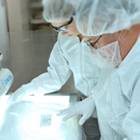BIOSS INC
Artikel-Nr:
(BOSSBS-13091R-A350)
Lieferant:
Bioss
Hersteller-Artikelnummer::
BS-13091R-A350
Lokale Artikelnummer::
BOSSBS-13091R-A350
Beschreibung:
This gene encodes a member of the epidermal growth factor (EGF) receptor family of receptor tyrosine kinases. This protein has no ligand binding domain of its own and therefore cannot bind growth factors. However, it does bind tightly to other ligand-bound EGF receptor family members to form a heterodimer, stabilizing ligand binding and enhancing kinase-mediated activation of downstream signalling pathways, such as those involving mitogen-activated protein kinase and phosphatidylinositol-3 kinase. Allelic variations at amino acid positions 654 and 655 of isoform a (positions 624 and 625 of isoform b) have been reported, with the most common allele, Ile654/Ile655, shown here. Amplification and/or overexpression of this gene has been reported in numerous cancers, including breast and ovarian tumors. Alternative splicing results in several additional transcript variants, some encoding different isoforms and others that have not been fully characterized. [provided by RefSeq, Jul 2008].
VE:
1 * 100 µl
Artikel-Nr:
(BOSSBS-12340R-CY7)
Lieferant:
Bioss
Hersteller-Artikelnummer::
BS-12340R-CY7
Lokale Artikelnummer::
BOSSBS-12340R-CY7
Beschreibung:
Vanin-2 is a 520 amino acid GPI-anchor protein that belongs to the CN hydrolase family and BTD/VNN subfamily.Widely expressed with high expression in spleen and blood, vanin-2 is suggested to be involved in thymus homing of bone marrow cells, regulation of Integrin ∫2-mediated cell adhesion, and migration and motility of neutrophils. Vanin-2 exists as five alternatively spliced isoforms and is encoded by a gene mapping to human chromosome 6q23.2.
VE:
1 * 100 µl
Artikel-Nr:
(BOSSBS-11274R-HRP)
Lieferant:
Bioss
Hersteller-Artikelnummer::
BS-11274R-HRP
Lokale Artikelnummer::
BOSSBS-11274R-HRP
Beschreibung:
This gene encodes the acidic form of complement factor 4, part of the classical activation pathway. The protein is expressed as a single chain precursor which is proteolytically cleaved into a trimer of alpha, beta, and gamma chains prior to secretion. The trimer provides a surface for interaction between the antigen-antibody complex and other complement components. The alpha chain may be cleaved to release C4 anaphylatoxin, a mediator of local inflammation. Deficiency of this protein is associated with systemic lupus erythematosus and type I diabetes mellitus. This gene localizes to the major histocompatibility complex (MHC) class III region on chromosome 6. Varying haplotypes of this gene cluster exist, such that individuals may have 1, 2, or 3 copies of this gene. Two transcript variants encoding different isoforms have been found for this gene. [provided by RefSeq, Nov 2011].
VE:
1 * 100 µl
Artikel-Nr:
(BOSSBS-1083R-A350)
Lieferant:
Bioss
Hersteller-Artikelnummer::
BS-1083R-A350
Lokale Artikelnummer::
BOSSBS-1083R-A350
Beschreibung:
Tyrosine-protein kinase that acts as a cell-surface receptor for VEGFC and VEGFD, and plays an essential role in adult lymphangiogenesis and in the development of the vascular network and the cardiovascular system during embryonic development. Promotes proliferation, survival and migration of endothelial cells, and regulates angiogenic sprouting. Signaling by activated FLT4 leads to enhanced production of VEGFC, and to a lesser degree VEGFA, thereby creating a positive feedback loop that enhances FLT4 signaling. Modulates KDR signaling by forming heterodimers. Mediates activation of the MAPK1/ERK2, MAPK3/ERK1 signaling pathway, of MAPK8 and the JUN signaling pathway, and of the AKT1 signaling pathway. Phosphorylates SHC1. Mediates phosphorylation of PIK3R1, the regulatory subunit of phosphatidylinositol 3-kinase. Promotes phosphorylation of MAPK8 at 'Thr-183' and 'Tyr-185', and of AKT1 at 'Ser-473'.
VE:
1 * 100 µl
Artikel-Nr:
(BOSSBS-3156R-CY3)
Lieferant:
Bioss
Hersteller-Artikelnummer::
BS-3156R-CY3
Lokale Artikelnummer::
BOSSBS-3156R-CY3
Beschreibung:
GCN2 belongs to a family of kinases that phosphorylate the alpha subunit of eukaryotic translation initiation factor 2 to downregulate protein synthesis in response to varied cellular stresses.
VE:
1 * 100 µl
Artikel-Nr:
(BOSSBS-3156R-FITC)
Lieferant:
Bioss
Hersteller-Artikelnummer::
BS-3156R-FITC
Lokale Artikelnummer::
BOSSBS-3156R-FITC
Beschreibung:
GCN2 belongs to a family of kinases that phosphorylate the alpha subunit of eukaryotic translation initiation factor 2 to downregulate protein synthesis in response to varied cellular stresses.
VE:
1 * 100 µl
Artikel-Nr:
(BOSSBS-1743R-A680)
Lieferant:
Bioss
Hersteller-Artikelnummer::
BS-1743R-A680
Lokale Artikelnummer::
BOSSBS-1743R-A680
Beschreibung:
Dopamine receptor whose activity is mediated by G proteins which inhibit adenylyl cyclase. Promotes cell proliferation (By similarity).
VE:
1 * 100 µl
Artikel-Nr:
(BOSSBS-0166R-A350)
Lieferant:
Bioss
Hersteller-Artikelnummer::
BS-0166R-A350
Lokale Artikelnummer::
BOSSBS-0166R-A350
Beschreibung:
This is a receptor for the tachykinin neuropeptide neuromedin-K (neurokinin B). It is associated with G proteins that activate a phosphatidylinositol-calcium second messenger system. The rank order of affinity of this receptor to tachykinins is: neuromedin-K >substance K >substance P.
VE:
1 * 100 µl
Artikel-Nr:
(BOSSBS-0165R-HRP)
Lieferant:
Bioss
Hersteller-Artikelnummer::
BS-0165R-HRP
Lokale Artikelnummer::
BOSSBS-0165R-HRP
Beschreibung:
Receptor tyrosine kinase binding ligands of the EGF family and activating several signaling cascades to convert extracellular cues into appropriate cellular responses. Known ligands include EGF, TGFA/TGF-alpha, amphiregulin, epigen/EPGN, BTC/betacellulin, epiregulin/EREG and HBEGF/heparin-binding EGF. Ligand binding triggers receptor homo- and/or heterodimerization and autophosphorylation on key cytoplasmic residues. The phosphorylated receptor recruits adapter proteins like GRB2 which in turn activates complex downstream signaling cascades. Activates at least 4 major downstream signaling cascades including the RAS-RAF-MEK-ERK, PI3 kinase-AKT, PLCgamma-PKC and STATs modules. May also activate the NF-kappa-B signaling cascade. Also directly phosphorylates other proteins like RGS16, activating its GTPase activity and probably coupling the EGF receptor signaling to the G protein-coupled receptor signaling. Also phosphorylates MUC1 and increases its interaction with SRC and CTNNB1/beta-catenin. Isoform 2 may act as an antagonist of EGF action.
VE:
1 * 100 µl
Artikel-Nr:
(BOSSBS-10397R-FITC)
Lieferant:
Bioss
Hersteller-Artikelnummer::
BS-10397R-FITC
Lokale Artikelnummer::
BOSSBS-10397R-FITC
Beschreibung:
This gene encodes coagulation factor VIII, which participates in the intrinsic pathway of blood coagulation; factor VIII is a cofactor for factor IXa which, in the presence of Ca+2 and phospholipids, converts factor X to the activated form Xa. This gene produces two alternatively spliced transcripts. Transcript variant 1 encodes a large glycoprotein, isoform a, which circulates in plasma and associates with von Willebrand factor in a noncovalent complex. This protein undergoes multiple cleavage events. Transcript variant 2 encodes a putative small protein, isoform b, which consists primarily of the phospholipid binding domain of factor VIIIc. This binding domain is essential for coagulant activity. Defects in this gene results in hemophilia A, a common recessive X-linked coagulation disorder. [provided by RefSeq, Jul 2008].
VE:
1 * 100 µl
Artikel-Nr:
(BOSSBS-10397R-A488)
Lieferant:
Bioss
Hersteller-Artikelnummer::
BS-10397R-A488
Lokale Artikelnummer::
BOSSBS-10397R-A488
Beschreibung:
This gene encodes coagulation factor VIII, which participates in the intrinsic pathway of blood coagulation; factor VIII is a cofactor for factor IXa which, in the presence of Ca+2 and phospholipids, converts factor X to the activated form Xa. This gene produces two alternatively spliced transcripts. Transcript variant 1 encodes a large glycoprotein, isoform a, which circulates in plasma and associates with von Willebrand factor in a noncovalent complex. This protein undergoes multiple cleavage events. Transcript variant 2 encodes a putative small protein, isoform b, which consists primarily of the phospholipid binding domain of factor VIIIc. This binding domain is essential for coagulant activity. Defects in this gene results in hemophilia A, a common recessive X-linked coagulation disorder. [provided by RefSeq, Jul 2008].
VE:
1 * 100 µl
Artikel-Nr:
(BOSSBS-3093R-CY3)
Lieferant:
Bioss
Hersteller-Artikelnummer::
BS-3093R-CY3
Lokale Artikelnummer::
BOSSBS-3093R-CY3
Beschreibung:
Tyrosine protein phosphatase which functions as a dosage-dependent inducer of mitotic progression. Directly dephosphorylates CDK1 and stimulates its kinase activity. Also dephosphorylates CDK2 in complex with cyclin E, in vitro.
VE:
1 * 100 µl
Artikel-Nr:
(BOSSBS-3093R-CY5.5)
Lieferant:
Bioss
Hersteller-Artikelnummer::
BS-3093R-CY5.5
Lokale Artikelnummer::
BOSSBS-3093R-CY5.5
Beschreibung:
Tyrosine protein phosphatase which functions as a dosage-dependent inducer of mitotic progression. Directly dephosphorylates CDK1 and stimulates its kinase activity. Also dephosphorylates CDK2 in complex with cyclin E, in vitro.
VE:
1 * 100 µl
Artikel-Nr:
(BOSSBS-11150R-CY7)
Lieferant:
Bioss
Hersteller-Artikelnummer::
BS-11150R-CY7
Lokale Artikelnummer::
BOSSBS-11150R-CY7
Beschreibung:
Protocadherins are a large family of cadherin-like cell adhesion proteins that are involved in the establishment and maintenance of neuronal connections in the brain. There are three protocadherin (PCDH) gene clusters, designated alpha, beta and gamma, all of which contain multiple tandemly arranged genes. PCDHGA9 (Protocadherin gamma-A9) is a 932 amino acid that is one of 22 proteins encoded by the protocadherin gamma cluster. The protocadherein gamma cluster consists of three subfamilies (A, B and C) and PCDHGA9 is a member of the gamma subfamily A. PCDHGA9 is a type I transmembrane receptor containing six cadherin motifs and is expressed in the central nervous system where it localizes to synapses. Members of the gamma cluster of protocadherins are essential for neuronal survival. There are two isoforms of PCDHGA9 that are produced as a result of alternative splicing events.
VE:
1 * 100 µl
Artikel-Nr:
(BOSSBS-4278R-A750)
Lieferant:
Bioss
Hersteller-Artikelnummer::
BS-4278R-A750
Lokale Artikelnummer::
BOSSBS-4278R-A750
Beschreibung:
This gene is an ortholog of the Drosophila fat gene, which encodes a tumor suppressor essential for controlling cell proliferation during Drosophila development. The gene product is a member of the cadherin superfamily, a group of integral membrane proteins characterised by the presence of cadherin-type repeats. In addition to containing 34 tandem cadherin-type repeats, the gene product has five epidermal growth factor (EGF)-like repeats and one laminin A-G domain. This gene is expressed at high levels in a number of foetal epithelia. Its product probably functions as an adhesion molecule and/or signaling receptor, and is likely to be important in developmental processes and cell communication. Transcript variants derived from alternative splicing and/or alternative promoter usage exist, but they have not been fully described.
VE:
1 * 100 µl
Artikel-Nr:
(BOSSBS-11734R-A350)
Lieferant:
Bioss
Hersteller-Artikelnummer::
BS-11734R-A350
Lokale Artikelnummer::
BOSSBS-11734R-A350
Beschreibung:
Located in the mitochondrial inner membrane, mitochondrial complex I is the first and largest enzyme in the electron transport chain of oxidative phosphorylation. By oxidizing NADH that is produced in the Krebs cycle, this complex utilizes the two electrons to reduce ubiquinone to ubiquinol, thereby initiating the passage of electrons to successive complexes and ultimately leading to the reduction of oxygen to water. Mitochondrial complex I consists of over 40 subunits and is of considerable clinical interest since defects in any of the subunits can lead to various myopathies and neuropathies. As a subunit of mitochondrial complex I, NDUFS7 (NADH dehydrogenase [ubiquinone] iron-sulfur protein 7), also designated NADH-ubiquinone oxidoreductase 20 kDa subunit, is a 213 amino acid protein that is suggested to be required for catalytic activity. Defects in the gene encoding NDUFS7 are the cause of Leigh syndrome, a severe neurological disorder that is characterized by bilaterally symmetrical necrotic lesions in subcortical brain regions.
VE:
1 * 100 µl
Preis auf Anfrage
Lager für diesen Artikel ist begrenzt, kann aber in einem Lagerhaus in Ihrer Nähe zur Verfügung. Bitte stellen Sie sicher, dass Sie in sind angemeldet auf dieser Seite, so dass verfügbare Bestand angezeigt werden können. Wenn das
Lager für diesen Artikel ist begrenzt, kann aber in einem Lagerhaus in Ihrer Nähe zur Verfügung. Bitte stellen Sie sicher, dass Sie in sind angemeldet auf dieser Seite, so dass verfügbare Bestand angezeigt werden können. Wenn das
Dieses Produkt kann nur an eine Lieferadresse versandt werden die über die entsprechende Lizenzen verfügt. Für weitere Hilfe bitte kontaktieren Sie Ihr VWR Vertriebszentrum.
-Additional Documentation May be needed to purchase this item. A VWR representative will contact you if needed.
Dieses Produkt wurde von Ihrer Organisation gesperrt. Bitte kontaktieren Sie Ihren Einkauf für weitere Informationen.
Dieses Produkt ist Ersatz für den von Ihnen gewünschten Artikel.
Dieses Produkt ist nicht mehr verfügbar. Bitte kontaktieren Sie den VWR Kundenservice.
|
|||||||||

















































